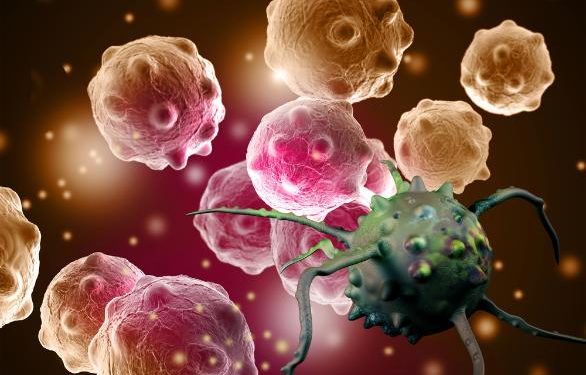BCC can be cured in almost all cases, especially if it is caught early. But it is very important to examine your skin regularly and talk to your doctor about any new growth or changes in an existing lesion.
Basal cell carcinoma develops on sun-exposed areas, most often the head and neck, but can also affect other parts of the body typically protected from the sun. It usually appears as a shiny bump, scaly patch or scab that doesn’t heal.
Causes
Basal cell carcinoma is the most common type of skin cancer. It happens when there’s a change (mutation) in the DNA of healthy cells that make up the bottom layer of your outer skin. The mutation can cause those cells to grow and form lumps or lesions in your skin. Basal cell carcinoma is more likely to happen if you have a lot of sun exposure, especially at a young age. But people of all races and skin types can get it.
Ultraviolet (UV) rays from the sun or indoor tanning beds are the main cause of BCC. These rays damage your skin over time and can lead to a buildup of damaged cells that makes a tumor. It also may be caused by a rare inherited condition called Gorlin’s syndrome that affects the basal cells.
When a basal cell carcinoma grows, it forms a pink, shiny bump or patch in your skin that doesn’t heal when you scratch it. It can also bleed after you touch it. The spot might look like a scar or a pimple that never goes away, and it might be very painful.
Most basal cell carcinomas stay in the skin where they started, but if left untreated, they can grow and spread to nearby tissues or bone. They can also recur after treatment. The chance of a recurrence depends on the size and location of the BCC, how it was treated, and your age.
Superficial basal cell carcinomas are small and pearly white or pink with raised areas through which dilated blood vessels may show (telangiectasia). They occur most often on the face, neck, chest, shoulders and arms, although they can appear anywhere. They can be a nuisance, especially when they bleed after you scratch them. They are more likely to recur than nodular basal cell carcinoma.
You’re more likely to get this type of skin cancer if you’ve had other types of skin cancer, such as basal cell carcinoma or squamous cell skin cancer. You’re also more likely to get it if you’ve had radiation therapy. You’re also at a higher risk for it if you live in an area with intense sunlight or at a high altitude, and if you have a weak immune system from disease or medicines such as HIV, chemotherapy or steroids that prevent organ rejection.
Symptoms
Basal cell carcinoma is the most common form of skin cancer. It often appears as a small sore or bump that doesn’t heal or that bleeds. This type of skin cancer grows slowly over time and is less likely to spread to other parts of the body than other types of skin cancers, but it may cause damage if left untreated.
BCCs grow from abnormal basal cells in the outermost layer of your skin. They rarely spread to other parts of the body, but they can become invasive and destroy the skin and nearby tissue or bone if they aren’t treated.
There are several types of basal cell carcinoma. Your doctor will examine your skin to diagnose basal cell carcinoma and figure out which one you have. The type of basal cell carcinoma you have will determine your treatment plan.
Nodular basal cell carcinoma may look like a round pimple or a scar and is the most common form of BCC. This type of basal cell carcinoma is usually very small and grows very slowly over time. Nodular basal cell carcinoma is usually white to pink in color but can be tan, black or brown, especially in people of color, and it may have tiny visible blood vessels on the surface of the skin.
Superficial spreading basal cell carcinoma grows very slowly, forming a thin, shallow mark that’s lighter in color than the surrounding skin. This type of basal cell carcinoma may bleed easily and it may scab over repeatedly. Superficial spreading basal cell carcinoma is most commonly seen on your arms, legs and face.
Sclerosing basal cell carcinoma forms thick, scaly patches that are darker in color than the surrounding skin. They also form ulcers that ooze clear fluid and bleed with slight touch or pressure. Sclerosing basal cell carcinoma is less common than the other types of basal cell carcinoma.
You can reduce your risk of getting basal cell carcinoma by avoiding the sun and using sunscreen regularly. See your dermatologist annually for a professional skin exam and do regular self-checks of the areas of your skin that are exposed to the sun or may be at risk for this cancer.
Diagnosis
BCCs are slow-growing skin cancers, but they can be quite dangerous if they are not diagnosed and treated promptly. They usually appear as a sore that won’t heal, or as a pink or flesh-colored bump that grows and bleeds. They often develop on sun-exposed areas of the body.
A skin biopsy is the only way to know if a spot is a basal cell carcinoma. This is done by injecting a local anesthetic into the area to numb it, and then removing a small piece of skin. The doctor will then examine the removed skin under a microscope. If the dermatologist sees cancerous basal cells, the diagnosis is confirmed. The doctor will also write a report about what was seen under the microscope (called a pathology report).
Basal cell carcinomas are less likely than squamous cell carcinoma to spread to other parts of the body, but they can grow into adjacent tissue and cause scarring. The chances of this happening are increased if the tumor is large or grows for a long time before being treated.
The type of treatment chosen depends on the type of basal cell carcinoma, its location and the patient’s medical history. For example, a large or aggressive BCC may be treated with radiation, which requires going to a hospital or a radiation specialist. Other options include surgical excision, electrodesiccation and curettage, cryotherapy and topical treatments such as 5-fluorouracil or imiquimod. Surgery has the lowest recurrence rate of all treatments.
If the cancer has reached a higher stage, your doctor may order a lymph node biopsy to see if any of the cancer has spread to nearby lymph nodes. Lymph nodes are immune system glands that trap invaders such as viruses and bacteria before they can spread to other organs in the body.
Treatment
A basal cell carcinoma may look like a wart, crusty spot, reddish patch, bump or mole. It is often slow-growing and appears on parts of the body that get a lot of sun. It may bleed or not bleed, but it should be evaluated by a dermatologist because they are the most common type of skin cancer that can grow to become dangerous.
If a doctor suspects a lesion is a basal cell carcinoma, they may do a skin biopsy to confirm the diagnosis. This is done by injecting a small amount of numbing medicine into the area, shaving off a sample and sending it to a lab for testing. Sometimes it is clear that the growth is a basal cell carcinoma from the initial examination, but in other cases the biopsy is needed to find out the stage of the tumor and how likely it is to spread.
The treatment for basal cell carcinoma depends on the stage and whether or not it has spread (metastasized). NewYork-Presbyterian offers a full range of nonsurgical treatments. Radiation is used for recurrent basal cell carcinoma or when surgery is not an option, such as when additional surgery would sacrifice major nerves or other important structures, or where the cancer has reached surrounding structures such as nerves, blood vessels and bones. Radiation can also be used as follow-up therapy to help kill any remaining cancer cells after surgery or other treatments.
Medication that is applied directly to the skin is another treatment for basal cell carcinoma, particularly in patients who cannot have surgery. The most commonly used medications are 5-fluorouracil (5-FU) and imiquimod 5% cream. They are typically applied to the skin twice a day for 3 to 6 weeks. Side effects of these drugs include itching, sores, tingling and redness of the skin.
Newer therapies are being investigated to treat more advanced basal cell carcinoma. The drug cemiplimab (ELD-001) is an immunotherapy that works with your own immune system to kill cancer cells and shrink tumors. It has been approved by the FDA for treating advanced basal cell carcinoma that has spread or recurred after other treatments. Other immunotherapy medications such as pembrolizumab and ipilimumab are being studied for recurrent or metastatic basal cell carcinoma of the skin and other types of cancer.









